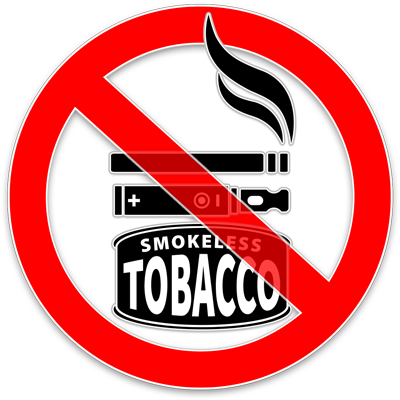Why Quit Smoking?
Mt. SAC is a Smoke, Tobacco, Vape-Free Campus!
Health Benefits
| Time Since Quitting | Health Benefit |
|---|---|
| 20 minutes | Heart rate and blood pressure drop |
| 12 hours | Carbon monoxide level in the blood drops to normal |
| 2-12 weeks | Circulation improves and lung function increases |
| 1-9 months | Coughing and shortness of breath decrease |
| 1 year | Risk of coronary heart disease is about half that of a smoker |
| 5 years | Stroke and cervical cancer risk is reduced to that of a nonsmoker and risk of cancer of the mouth, throat, esophagus and bladder are about half that of a smoker |
| 10 years | Risk of lung cancer falls to about half that of a smoker and the risk of cancer of the larynx and pancreas decreases |
| 15 years | The risk of coronary heart disease is that of a nonsmoker's |
Additional Benefits
- Breathe easier and increase stamina and endurance when exercising
- Improve health overall with less coughing, wheezing, and shortness of breath
- Feel more energetic and confident
- Save money
- Smell better (i.e., no more smoky house, clothes, hair, car, etc.)
- Improve sense of smell and taste
- Whiter teeth and fresher breath
- No more stains on fingers/fingernails
- Sharper thinking
- More social acceptance
- No longer expose family and friends to secondhand smoke
Nicotine and the Body
- Nicotine is a highly addictive drug found naturally in tobacco.
- When a smoker inhales tobacco smoke, nicotine is absorbed into the bloodstream through the lungs and carried to every part of the body along with carbon monoxide and other toxins.
- Over time, smokers develop a tolerance to nicotine as their nervous system adapts to it, which leads to an increase in smoking to keep the level of nicotine in the blood at a comfortable range and avoid withdrawal symptoms.
- Smoking regularly for only a few weeks will lead to withdrawal symptoms should the person suddenly stop using or significantly reduce their use.
- Withdrawal symptoms are both physical and mental and they can last for a few days or several weeks. Symptoms of nicotine withdrawal may include dizziness, anxiety, irritability, depression, poor concentration, headaches, sleep disturbances, increased appetite, restlessness, fatigue and strong cravings for nicotine.
- In order to quit for good, the physical, mental and emotional dependence on nicotine must be addressed. Although possible, this is NOT easy! Breaking an addiction to nicotine can be as difficult as overcoming an addiction to heroin or cocaine.
Smoking and Tobacco Use
- Smoking is the leading cause of preventable disease and death in the US. According to the CDC (2014), "nearly half a million Americans die prematurely from tobacco use each year." On average, smokers die at least 10 years earlier than nonsmokers.
- Studies have linked smoking to diseases in almost every organ of the body. Smoking can cause mouth, throat, lung, stomach, kidney, bladder, cervix, and other types of cancer, heart and lung disease, stroke, diabetes, and reproductive issues. (Source)
- In general, smokers have more health issues than nonsmokers because smoking compromises the immune system, which makes it difficult for the body to fight disease and infection.
- For young adults, nicotine exposure can have lasting effects on brain development. Youth who smoke are also in danger of becoming addicted to nicotine and lung growth and function may be reduced.
- People exposed to secondhand smoke are at risk for many of the same health problems as smokers including heart disease, stroke, and lung cancer. According to the American Cancer Society (2012), the majority of secondhand smoke deaths are among women and children.
Smoking and the Environment
Deforestation
- The tobacco industry causes 500,000 acres of deforestation per year, which equates to an area 5 times the size of Las Vegas.
- In many poor countries, where tobacco is made, wood is burned to dry out the leaves. It takes up to 5.7 pounds of wood to dry the leaves for only one pack of cigarettes (NOT including the paper on the cigarette or the packaging).
- An entire tree is burned to cure the tobacco necessary for just 15 packs of cigarettes (i.e., about a 2 week supply for a pack-a-day smoker).
- A cigarette-manufacturing machine uses 4 miles of paper per hour to roll and package cigarettes.
- Cigarette butts leach toxic chemicals (e.g., arsenic, cadmium, lead, polycyclic aromatic hydrocarbons) that pollute the environment, kill marine life and harm ecosystems.
- Gersberg (2009) found that the chemicals in only one filtered cigarette butt were toxic enough to kill fish living in a one-liter bucket of water.
- Each year, an estimated 1.69 billion pounds of cigarette butts are littered worldwide.
- When it rains, cigarette butts lying in the streets and gutters are washed into harbors, beaches and rivers where they harm marine life. Cigarette butts have been found in the stomachs of young birds, sea turtles and other marine creatures.
- Cigarette filters are made of cellulose-acetate, which is not readily biodegradable. Cigarette butts can take up to 12 months to break down in fresh water and up to 5 years to breakdown in seawater.

 For the health and safety of our community and environment, Mt. San Antonio College
is a Smoke-Free, Tobacco Free, and Vape-Free campus.
For the health and safety of our community and environment, Mt. San Antonio College
is a Smoke-Free, Tobacco Free, and Vape-Free campus.